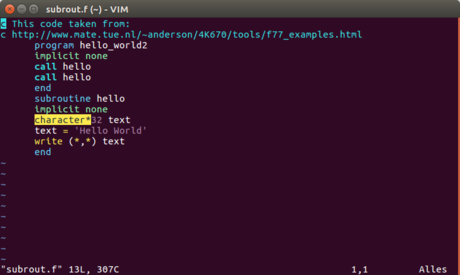Mastering FORTRAN Programming for Engineering Applications: A Comprehensive Guide
James April 15, 2024
Introduction: FORTRAN (Formula Translation) is one of the oldest and most widely used programming languages in the field of engineering and scientific computing. Developed in the 1950s, FORTRAN revolutionized numerical computation and played a key role in advancing computational science and engineering. In this comprehensive guide, we will explore the intricacies of programming in FORTRAN for engineering applications, covering everything from basic syntax to advanced techniques for numerical analysis, simulation, and optimization.
Section 1: Understanding FORTRAN Programming
1.1 Historical Overview: FORTRAN was developed by IBM in the late 1950s to address the need for a high-level programming language for numerical computation. It introduced many groundbreaking features, including array processing, mathematical functions, and efficient memory management, making it ideal for scientific and engineering applications.
1.2 Features of FORTRAN: FORTRAN is known for its simplicity, efficiency, and suitability for numerical computation. It offers built-in support for mathematical functions, array operations, and numerical algorithms, making it well-suited for solving complex engineering problems such as differential equations, optimization, and data analysis.
1.3 Importance in Engineering: FORTRAN has been widely adopted in engineering disciplines such as aerospace, mechanical, civil, and electrical engineering, where numerical analysis and simulation are essential. It remains popular due to its performance, reliability, and extensive library of numerical routines for solving engineering problems.
Section 2: Getting Started with FORTRAN Programming
2.1 Setting up the Development Environment: To program in FORTRAN, engineers need a suitable development environment, which typically includes a FORTRAN compiler, text editor, and debugging tools. Popular compilers include GNU Fortran (GFortran), Intel Fortran Compiler, and IBM XL Fortran, which are available for various operating systems.
2.2 Basic Syntax and Structure: FORTRAN programs consist of statements written in free-form or fixed-form format. Key components include program units, variables, data types, control structures (such as loops and conditionals), functions, and subroutines. Engineers write code to perform calculations, manipulate data, and solve engineering problems.
2.3 Data Types and Declarations: FORTRAN supports various data types, including integers, real numbers, complex numbers, logical values, and character strings. Engineers declare variables using appropriate data types and specify attributes such as size, precision, and dimensionality to define the memory layout and storage requirements.
Section 3: Programming Techniques for Engineering Applications
3.1 Numerical Computation: FORTRAN excels in numerical computation, offering efficient implementations of mathematical functions, numerical algorithms, and computational methods. Engineers use FORTRAN to solve engineering problems such as linear algebra, differential equations, optimization, interpolation, and numerical integration with high accuracy and performance.
3.2 Array Processing: FORTRAN provides robust support for array processing, allowing engineers to manipulate multidimensional arrays efficiently. Engineers use array operations, slicing, indexing, and broadcasting to perform matrix operations, vector calculus, signal processing, image processing, and data analysis tasks in engineering applications.
3.3 File I/O and Data Handling: FORTRAN supports file input/output (I/O) operations for reading and writing data to external files, such as text files, binary files, and formatted files. Engineers use file I/O routines to import data from sensors, instruments, and simulations, as well as to export results, reports, and visualization data for further analysis.
Section 4: Advanced Techniques for Engineering Applications
4.1 Modular Programming: Engineers adopt modular programming techniques in FORTRAN to organize code into reusable modules, functions, and subroutines. Modular programming promotes code modularity, reusability, and maintainability, allowing engineers to develop scalable, modular, and extensible software for complex engineering systems.
4.2 Parallel Computing: FORTRAN supports parallel computing techniques for exploiting multicore processors, distributed memory systems, and high-performance computing (HPC) clusters. Engineers use parallel programming models such as OpenMP and MPI to parallelize numerical algorithms, simulations, and data processing tasks for improved performance and scalability.
4.3 Interfacing with Other Languages: Engineers can interface FORTRAN code with other programming languages, libraries, and tools to leverage existing software, extend functionality, and integrate with third-party applications. Engineers use interoperability features such as Foreign Function Interfaces (FFI), interoperable data types, and language bindings to communicate between FORTRAN and other languages such as C/C++, Python, and MATLAB.
Section 5: Best Practices and Tips for FORTRAN Programming
5.1 Code Optimization: Follow best practices for code optimization to improve performance, efficiency, and readability of FORTRAN programs. Optimize algorithms, minimize memory usage, reduce computational complexity, and use compiler optimizations to maximize code efficiency and execution speed for engineering applications.
5.2 Documentation and Comments: Document FORTRAN code thoroughly with comments, annotations, and descriptive variable names to enhance readability, maintainability, and collaboration. Use meaningful identifiers, inline comments, and documentation tools to provide context, explanations, and usage instructions for code segments and functions.
5.3 Error Handling and Debugging: Implement robust error handling and debugging techniques to identify and fix errors, bugs, and logical flaws in FORTRAN programs. Use debugging tools, error messages, and runtime diagnostics to trace program execution, identify problematic code segments, and resolve issues efficiently for reliable engineering applications.
Conclusion: FORTRAN programming continues to be a valuable skill for engineers working in various fields of engineering and scientific computing. By mastering the principles, techniques, and best practices discussed in this guide, engineers can leverage FORTRAN to develop efficient, reliable, and scalable software solutions for solving complex engineering problems, conducting numerical analysis, and simulating real-world systems. With its rich history, powerful features, and widespread adoption in engineering disciplines, FORTRAN remains a cornerstone of computational science and engineering, empowering engineers to push the boundaries of innovation and discovery in the quest for technological advancement.




